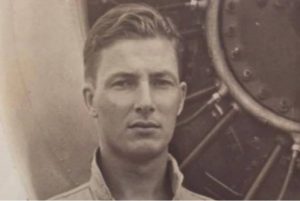December 5, 2018
Recently Recovered Banshee Debris To Form Museum Exhibit
admincopa
It was to be a short flight for Royal Canadian Navy (RCN) Lieutenant William Thomas Barry Troy, who was participating in training exercises with his American counterparts on February 25, 1958. Troy, 27, was piloting a single-seat RCN McDonnell Banshee jet fighter from a U.S. naval air station near Jacksonville, Florida to the HMCS Bonaventure, a Canadian aircraft carrier located roughly 35 nautical miles off the Florida coast.
Troy, who hailed from Cambellton, N.B., encountered a fog bank. Three other Banshees flying with him turned right, away from the fog, and returned safely to shore. Troy, however, veered left toward the Bonaventure. Flying low over the water, he was never heard from again. A search turned up some aircraft debris, but no body.

Navy Lieutenant William Thomas Barry Troy
Fast forward to Sept. 10, 2017. Hurricane Irma stormed into Florida on that day, leaving much turmoil and destruction in its wake. But it also disturbed the shoreline enough to uncover items that were eventually linked to Troy; a shredded parachute and a ‘Mae West’ life preserver were found by Zack Johnson, a park ranger participating in the cleanup of the beach. Johnson noticed the name ‘Troy’ on the strap, along with NATO markings. He shared his discovery on Facebook, where it caught the eye of Shearwater Aviation Museum curator Christine Hines.
Other pieces of wreckage from Troy’s Banshee were also recovered on the beach. The U.S. Department of Defense held a repatriation ceremony in Florida earlier this year and the items were subsequently returned to Canada, where they eventually ended up in the Shearwater Aviation Museum in Nova Scotia, where they are to form a special exhibit to open in early 2019.
“The Cold War soldiers, sailors and airmen is a story you don’t hear a lot about,” Hines told the Halifax Chronicle Herald. “There’s not a lot of medals, there were a lot of accidents. It was a war of deterrence, not necessarily a trench war, so it’s really a different story. So there’s not as much awareness of that Cold War era.” Hines continued, “We have to remember them. We have to remember the reason they signed on the dotted line, the reason why they wanted to serve their country.”
